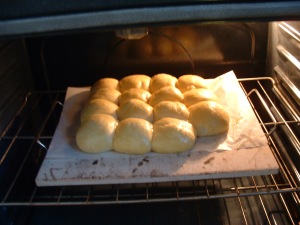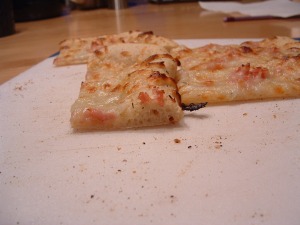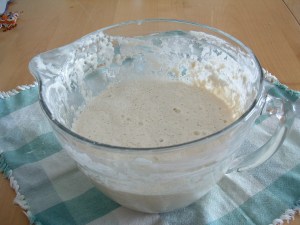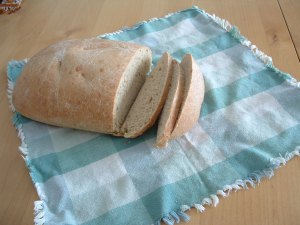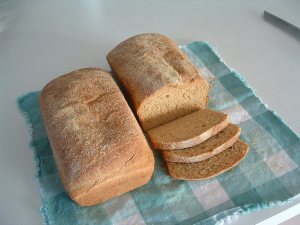I have a sourdough formula that stands as my family’s main bread (we gave up buying bread from the store about a year ago). We use it for sandwiches, toast, French toast (when it’s a little stale), crouton (when it’s REALLY stale), broiled, baked, fried, plain, you name it. It’s good.
I make a 3 lb batch which I normally shape into a 2 lb loaf and use the other 1 lb to play with other shapes like torpedoes. Normally I mix the ingredients, hand knead for 10 or 12 minutes, primary ferment for 1 1/2 hours, shape, proof, and bake. It sounds like a lot, but there is only about 15 minutes of active time for me in that process. Earlier in the week, I started to make my normal 3 pound batch and had something pop up at work. I essentially had time to mix the ingredients and set the mixing bowl aside.
While working, I kept feeling concerned about how the dough would develop (anxious about gluten development is for the geek in me) and I figured it was a good day to try the stretch and fold technique favored by so many home bakers. This technique doesn’t manually develop the dough like kneading does, but allows enzymes to do the work of gluten development for you. Which takes time and not muscle. The basic idea is to let the mixed ingredients sit for 40 minutes, then pour them out on the counter and stretch them and fold them and plop them back in the mixing bowl for another 40 minute rest. Repeat this stretch, fold, and rest 3 or 4 times and you have a nice dough that is developed by brains and not muscle… or at least by science.
In my attempt to bake bread, I kept getting pulled away. So between the 2nd and 3rd stretch I threw the batch in the refrigerator and left it there for 4 hours or so. I then pulled it out of the fridge and let it warm up so I could stretch, fold, and then back in the bowl for a rest. After an hour I was able to shape 2 loaves (about a 1 1/2 lbs each) into some bread pans. Unfortunately, I was pulled away again so I threw the pans into the refrigerator for an overnight retard. The next morning I pulled out the loaves and let them warm up on the counter again, for about an hour, and warmed up the oven for some baking.
At this point, the dough had been stretch and folded 3 or 4 times, but was in and out of the refrigerator 2 times and was nearly 24 hours old. To my surprise the dough still looked good. It had developed into a strong airy mesh of dough with lots of character. When I shaped the dough it was supple but very resistant to shaping. I normally used to the knead method of dough development and the shaping is done with supple but mushy dough. This was far different. The shaped loaves where huge in the pan before proofing!
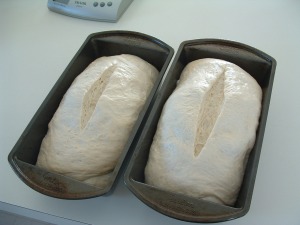
Once the loaves baked, I was surprised at how light and tender the crumb was (I wish I had a good shot of the crumb). One thing I noticed was that the sour part of the sourdough was VERY tangy. It might be too tangy for some of our normal uses for bread, but as toast and sandwich bed it’s super good.
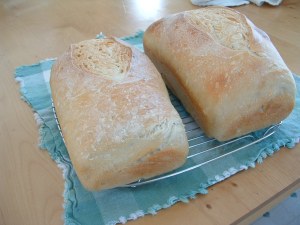
I’m impressed with the crumb of the bread; it is so light and airy. I’m pretty sure it is due to the dough development technique. I’ve kneaded or dough-hooked my bread for a couple of years now and haven’t had this type of development before. Also, I’m impressed with how durable the bread was. I neglected it many times and simply stuffed it in the fridge anytime I didn’t have time to deal with it. AND, it still turned out delicious.
The only draw back is that stretch and fold takes so much time! 3 or 4 stretch, fold, and rest cycles is nearly 4 hours of waiting. I can finish off two batches of knead and proof bread in that time. I’m willing to try all of my formulas with this technique though. I wonder if my Greek Celebration bread would have been so airy and light. It might have been really good with some more air in it. Does anyone know how to stretch and fold pizza dough?
